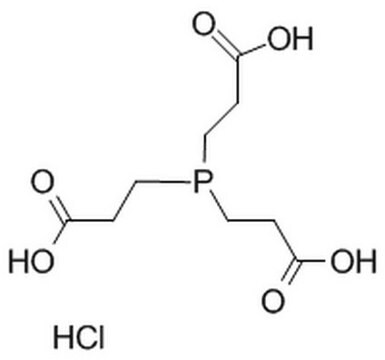Wszystkie zdjęcia(1)
Kluczowe dokumenty
52486
Tris(2-carboxyethyl)phosphine, immobilized on Agarose CL-4B
Synonim(y):
TCEP-Agarose, Tris(2-carboxyethyl)phosphine-Agarose
Zaloguj sięWyświetlanie cen organizacyjnych i kontraktowych
About This Item
Kod UNSPSC:
12352204
Polecane produkty
Poziom jakości
temp. przechowywania
2-8°C
Zastosowanie
Tris(2-carboxyethyl)phosphine, immobilized on agarose CL-4B may be used in preliminary off-line experiments to study its ability to cleave disulfide bonds by both under flow conditions using sequential injection analysis (SI). It may also be used as a reducing agent in bio-tests for disrupting the disulfide bonds within and between the proteins.
Działania biochem./fizjol.
Tris(2-carboxyethyl)phosphine also referred to as TCEP reduces the disulfides by the usual mechanism of reduction of disulfides by phosphines in water. Tris(2-carboxyethyl)phosphine, immobilized on Agarose CL-4B,Trialkylphosphines (TCEP) are highly effective agents for reducing disulfide bonds in proteins, peptides and other disulfide bondcontaining molecules and are relatively non-reactive toward other functional groups. The trialkylphosphine TCEP was first described by Levison et al. as an odorless and efficient reductant of alkyl disulfides over a wide pH range. TCEP is stable in aqueous solutions and does not undergo the rapid oxidation that often occurs with other reducing agents such as dithiotreitol (DTT) and β-mercaptoethanol (BME, 2-ME). TCEP does not interfere with commonly used sulfhydryl-reactive reagents (e.g., maleimide crosslinkers). Nevertheless, many protocols require recovery of the reduced sample separate from the reducing agent. Our Tris(2-carboxyethyl)phosphine, immobilized on Agarose CL-4B eliminates the need to use laborious and troublesome gel filtration methods to separate the reduced sample from the reducing agent. Immobilized TCEP Disulfide Reducing Gel may be adapted conveniently to a variety of scales and formats. Examples are given for batch, spin cup column and gravity-flow column procedures. For small-scale reductions, the most complete sample recovery is made using the spin-cup column procedure (see Related Thermo Scientific Products Section).
Komentarz do analizy
Bio-tests
Gel has an effective TCEP concentration ≥8 μmol/mL gel
Gel has an effective TCEP concentration ≥8 μmol/mL gel
Ta strona może zawierać tekst przetłumaczony maszynowo.
Kod klasy składowania
10 - Combustible liquids
Klasa zagrożenia wodnego (WGK)
WGK 3
Temperatura zapłonu (°F)
Not applicable
Temperatura zapłonu (°C)
Not applicable
Wybierz jedną z najnowszych wersji:
Masz już ten produkt?
Dokumenty związane z niedawno zakupionymi produktami zostały zamieszczone w Bibliotece dokumentów.
Klienci oglądali również te produkty
Preparation of Avidin Conjugates
Haugland, R.P. and Blalgat, M.K et al.
Methods in Molecular Biology, 189-190 (1998)
Burns, J.A.
The Journal of Organic Chemistry, 56, 2648-2648 (1991)
J C Han et al.
Analytical biochemistry, 220(1), 5-10 (1994-07-01)
The concentration of tris(2-carboxyethyl)phosphine (TCEP) can be conveniently determined by measuring the amount of 2-nitro-5-thiobenzoate (NTB) formed after reaction with 5,5'-dithiobis(2-nitrobenzoic acid) (DTNB). This method utilizes the fact that TCEP reduces DTNB rapidly and stoichiometrically to generate two equivalents of
Nasz zespół naukowców ma doświadczenie we wszystkich obszarach badań, w tym w naukach przyrodniczych, materiałoznawstwie, syntezie chemicznej, chromatografii, analityce i wielu innych dziedzinach.
Skontaktuj się z zespołem ds. pomocy technicznej




